INTRODUCTION
The Kraków-Częstochowa Upland is an area offering favourable conditions for molluscs. On the one hand, this is supported by the presence of carbonate rocks, mainly limestone, in the bedrock and, on the other hand, by the varied landforms that allow a wide variety of natural habitats. Studies of the malacofauna of the area began back in the late 19th century (e.g. Jachno 1870, Błędowski & Demel 1913, Poliński 1914, Urbański 1973, 1977) and have been continuously carried out up to the present day (e.g. Šteffek et al. 1990, Pawłowski et al. 2008, Stworzewicz 2008). Through these studies, more than 110 species of terrestrial gastropods have been identified, including some 90 species of shelled gastropods (Riedel 1988, Wiktor 2004). Also very advanced are studies of the subfossil malacofauna found in Quaternary sediments (e.g. Alexandrowicz S. W. 1983, 1987, Alexandrowicz W. P. 2004, 2021). One of the more common types of sediment analysed for the presence of gastropod shells is the one accumulating within karst forms. Studies of mollusc faunas in the deposits filling large caves have provided a wealth of palaeoenvironmental data used most often in archaeological reconstructions (e.g. Kowalski et al. 1965, 1967, Wiktor et al. 1967, Stworzewicz 1973, 1988, 2004, Nadachowski et al. 1989, Dagnan-Ginter et al. 1992, Alexandrowicz S. W. et al. 1992, Cyrek et al. 2000, Wilczyński et al. 2012, 2020, Szymanek et al. 2016, Krajcarz et al. 2020, Alexandrowicz W. P. 2022). Sediments filling small karst forms (rock niches, open karst fissures, small sub-rock shelters) have also been analysed, although to a much lesser extent (e.g. Alexandrowicz S. W. 1992, 2000, Alexandrowicz W. P. 2000, Alexandrowicz S. W. & Alexandrowicz Z. 2003). However, these small karst forms represent a very interesting, albeit underexplored, field of inquiry. They are widespread; their sediments often contain very abundant accumulations of mollusc shells, and they are easily sampled. Furthermore, small karst forms occur in different parts of limestone rocks (on slopes with other exposures and gradients, in zones overgrown with various plant formations). The local nature of such sites makes them exceptionally useful for conducting micro-habitat studies and characterising the variability of habitat features within groups of rocks or even individual forms. It should be noted, however, that sedimentary and, consequently, malacological sequences within the fills of small karst forms almost always represent short periods of a few hundred years. Studies of subfossil faunas occurring in the fills of the discussed formations in the southern part of the Kraków-Częstochowa Upland indicate that almost all of them are associated with the last several hundred years (historical period) (e.g. Alexandrowicz S. W. 1992, 2000, Alexandrowicz W. P. 2000, Alexandrowicz S. W. & Alexandrowicz Z. 2003). Thus, the sites where older fills have been preserved are extremely interesting and unique.
The main aim of the study was to present the diversity of mollusc communities occurring in the fills of small karst formations of different ages as indicators of environmental changes during the Holocene. The second intention was to indicate differences in the characteristics of mollusc communities occurring in fills of the same age, representing different types of microhabitats (open vs. shaded habitats) and to compare subfossil assemblages with contemporary malacofauna inhabiting the analysed area.
CHARACTERISTICS OF THE SITES
Witkowe Rocks are one of the many groupings of limestone rocks in the Jerzmanowice area of the Kraków-Częstochowa Upland. They are located on the west slope of the Szklarka Valley, about 1.5 km south-west of the Jerzmanowice village centre (GPS: 50°12'2"N, 19°43'31"E) (Figs 1–2). They comprise seven isolated rocks that have vertical walls and reach heights of several to over a dozen meters (Figs 3–4). Witkowe Rocks are made of white, massive, bioherm limestones representing the Upper Jurassic and are classified in the so-called rocky limestone facies (Krajewski & Matyszkiewicz 2009).
Figs 1–2
General (1) and detailed (2) location of the Witkowe Rocks (map base: www.polska.e-mapa.net)
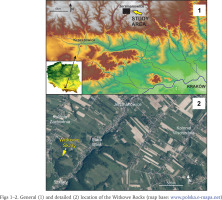
Figs 3–6
Morphology of the Witkowe Rocks and profile location: 3 – aerial photo of the Witkowe Rocks (photo base: www.polska.e-mapa.net), 4 – hypsometric map of the Witkowe Rocks (map base: www.polska.e-mapa.net), 5 – location of the malacological profiles, 6 – western slopes of the Witkowe Rocks (photo: W. P. Alexandrowicz)
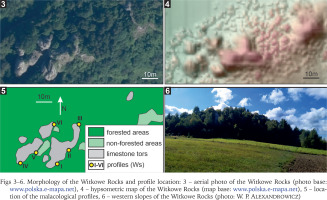
Like other rock formations in the Jerzmanowice area, Witkowe Rocks are karst inliers. The genesis of these forms has been the subject of numerous studies (Dżułyński et al. 1966, Alexandrowicz S. W. & Alexandrowicz Z. 2004, Lewandowski 2015). The beginnings of the formation of the modern landscape of the southern part of the Kraków-Częstochowa Upland date back to the Paleogene. At that time, the area was inland, and karst processes developed on a large scale in the warm and humid climate. These resulted in the formation of extensive cave systems and, ultimately, a flat-topped upland. The limestone within the Upper Jurassic carbonate formation, which is more resistant to destructive factors than the accompanying facies (bedded and lamellar limestone), has been cropped out and now forms inliers rising several tens of meters above the surface of the aforementioned flat-topped upland (Dżułyński et al. 1966, Alexandrowicz S. W. & Alexandrowicz Z. 2004, Lewandowski 2015).
The area around Witkowe Rocks is an agricultural land occupied by arable fields, but the hill is covered with deciduous forest, and shaded habitats predominate. Only some parts of the limestone walls facing south or southeast are exposed and receive strong sunlight (Figs 3–6).
Within the Witkowe Rocks are numerous small forms of surface karst (rock niches, rock shelters, crevices, and shelves). Some of these forms have preserved sedimentary fillings with a small thickness ranging from several to several dozen centimetres. Six such profiles were the subject of malacological analyses. The locations of the research profiles are shown in Fig. 5.
MATERIAL AND METHODS
During the fieldwork conducted in spring 2023, observations were made of the lithological variability of the sediments filling the small karst forms, and samples were taken for malacological studies. A total of 27 samples containing mollusc shells were obtained from six profiles (Ws-I – Ws-VI) (Figs 3–6). The samples were sectional, closely associated with the lithological formation of the sediments, and a weight of ca. 2 kg each. After laboratory processing including maceration and drying, all mollusc shells and fragments that allowed determination were selected. Designations were based on keys (Wiktor 2004, Welter-Schultes 2012, Horsák et al. 2013) and comparative collections. Once the abundance of individual taxa was determined, they were classified into ecological groups according to the scheme developed by Ložek (1964) with its modifications (Alexandrowicz S. W. & Alexandrowicz W. P. 2011, Juřičková et al. 2014a). The calculated percentages of species and ecological groups allowed the compilation of malacological spectra of individuals (MSI), which are the basis for palaeoenvironmental interpretation. Concurrently, qualitative observations were carried out to identify species living in the area of Witkowe Rocks today. These studies were conducted in spring 2023 at 20 selected sites representing zones with different exposure and plant cover. The malacofauna of shaded habitats was analysed at fourteen sites, three representing grasslands and the remaining three representing exposed rock walls. The collection was carried out by hand, and the malacofauna was recorded directly in the field. Slugs were not considered. The ecological structure of the modern fauna of Witkowe Rocks is shown on the malacological spectra of species (MSS). The zoogeographical analysis was based on the zoogeographical distribution of molluscs described by Alexandrowicz S. W. & Alexandrowicz W. P. (2011). To distinguish and characterise the main faunal types, a similarity dendrogram analysis was carried out using the UPGMA clustering method and Morisita’s algorithm (Morisita 1959). This allowed four faunal assemblages to be identified. Statistical analyses were performed using PAST software (Hammer et al. 2001).
The age of the sediments was determined by the occurrence of species of stratigraphic relevance and by comparing the assemblages of the fauna with subfossil malacocoenoses reported and dated at other Quaternary sediment sites in the southern part of the Kraków-Częstochowa Upland, as well as by comparison with the taxonomic diversity of the modern fauna found in the area.
RESULTS
RECENT MALACOFAUNA
There is a relatively rich mollusc fauna in Witkowe Rocks, including 58 species (Tables 1–2). The malacofauna identified in the wooded zones was abundant and included 48 species, among which shade-loving taxa were predominant. Almost 70% of the species identified belonged to this group (Fig. 7). The most numerous families were Clausiliidae, Zonitidae, and Helicidae. Noteworthy is the presence of several species that are rare for the southern part of the Kraków-Częstochowa Upland, such as Acicula parcelineata, Discus perspectivus, Ruthenica filograna, and Vitrea subrimata. Mesophilous taxa constitute the second important component of the analysed fauna. There are both species typical of medium-humidity habitats (Cochlicopa lubrica, Punctum pygmaeum, Clausilia dubia) and humid environments (Succinella oblonga, Arianta arbustorum), although the former are more numerous. Open-country species were of marginal importance and were represented only by Vallonia pulchella and V. costata (Fig. 7). The malacofauna found in grasslands and/or on the walls of limestone rocks was much less diverse and included 25 taxa (Tables 1–2). Its most prominent component was species typical of open, often strongly sunlit habitats. This includes both species preferring grass biotopes (V. pulchella and V. costata, Pupilla muscorum) and those living on exposed limestone surfaces (Pyramidula pusilla, Chondrina clienta, Pupilla sterrii). In addition, there were mesophilous taxa of dry habitats (Cochlicopa lubricella) and moderately moist habitats (C. lubrica, P. pygmaeum). Besides Alinda biplicata and Laciniaria plicata, shade-loving species and forms requiring more moist habitats were scarce (Fig. 7).
Fig. 7
Lithology of deposits filling small karst forms, subfossil, and recent malacofauna. E – ecological groups of molluscs, MSI – malacological spectrum of individuals, MSS – malacological spectrum of species, Pr – lithological profiles, Sm – samples
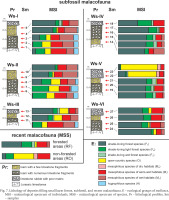
Table 1
Malacofauna in profiles of sediments filling small karst forms at Witkowe Rocks: RF – recent fauna of shaded zones, RO – recent fauna of grasslands and rocky walls, A–D – molluscan assemblages described in the text, E – ecological groups of molluscs (after Ložek (1964), Alexandrowicz S. W. & Alexandrowicz W. P. (2011), Juřičková et al. (2014a)): FF – shade-loving forest species, FB – shade-loving light forests species, FH – shade-loving wet forests species, O – open-country species, MD – mesophilous species of dry habitats, MI – mesophilous species of semi-wet habitats, MH – mesophilous species of wet habitats, H – hygrophilous species. ZG – zoogeographical groups of molluscs (after Alexandrowicz S. W. & Alexandrowicz W. P. (2011)): Hl – Holarctic species, Pl – Palearctic species, Ep – European species, Me – Central-European upland species, Ma – Central-European mountain species, En – North-European species, Ee – East-European species, Eb – Balkan species, Em – South-European species, Ew – West-European species, Ba – Boreal-Alpine species

Table 2
Diversity of subfossil and recent malacofauna in the area of Witkowe Skały: Ws-I – Ws-VI – profiles, RF – recent fauna of shaded zones, RO – recent fauna of grasslands and rocky walls, F – shade-loving species, O – open-country species, M – mesophilous species, H – hygrophilous species, CLS – cold-loving species (Semilimax kotulae, Columella columella, Vertigo arctica, Vertigo geyeri), N – number of species/specimens
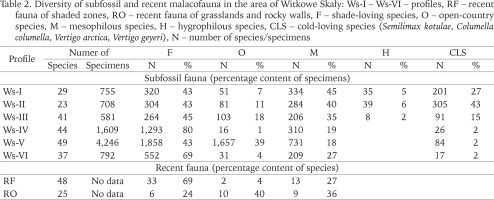
LITHOLOGY OF SEDIMENTS
The lithological sequences filling small karst forms were characterised by a thickness ranging from 25 to 60 cm. The fills analysed are relatively homogeneous in terms of lithological formation. The most common sediment type is yellow, sometimes ash-grey or brown silt. Within them, sharp-edged blocks of Jurassic limestone appear. Individual profile intervals may differ in the number of rock fragments (in some places, limestone blocks appear sporadically, and in others, they are very numerous with a small amount of silty matrix) and in the size of the fragments (diameters vary from 2–3 cm sometimes reaching up to 10 cm). In addition to numerous mollusc shells, bones of small vertebrates also appeared in the sediments analysed. The lithological characteristics of the individual profiles are presented in Fig. 7.
SUBFOSSIL MALACOFAUNA
Studies of the subfossil mollusc fauna carried out in six profiles (Ws-I – Ws-VI) identified 54 land snail species represented by almost 7,000 specimens (Tables 1–2).
As in the case of the present-day malacofauna, shade-loving taxa are the most abundant (34 species; about 63% of the fauna) (ecological groups FF, FB, and FH). Taxa with high environmental and thermal requirements (Discus perspectivus, D. rotundatus, R. filograna) and snails preferring cooler climates (D. ruderatus), as well as cold-loving forms (Semilimax kotulae) are present here. Noteworthy is the presence of several species that are not recorded alive in the Kraków-Częstochowa Upland. This group includes Argna bielzi, Eucobresia nivalis, S. semilimax and Vestia turgida. These taxa have only been found in Quaternary sediments from the southern part of the Kraków-Częstochowa Upland (e.g. Alexandrowicz S. W. 1983, 1987, Alexandrowicz W. P. 2004, 2021, Pawłowski et al. 2008). Open-country species, including those that live on exposed rocks or in grassland (ecological group O), are represented by eight taxa (15% of the fauna). Due to the significant degree of shading of Witkowe Rocks, this group is a relatively minor component of the assemblage. It is more numerous in only two samples. Particularly noteworthy is the occurrence of the cold-loving species Columella columella. The mesophilous species (ecological groups MD, MI, and MH) include 11 taxa (20% of the fauna). It mainly comprises widely distributed snails with high ecological and thermal tolerance. Noteworthy is the occurrence of a cold-loving taxon – Vertigo arctica. Hygrophilous snails (ecological group H) are represented by only one cold-loving taxon: Vertigo geyeri (Fig. 7, Tables 1–2).
DIVERSITY OF THE MALACOFAUNA OF SMALL KARST FORMS
The profiles analysed can be divided into two groups. The first one includes the profiles Ws-I, Ws-II and Ws-III. The malacofauna found here is characterised by low taxonomic diversity (the number of taxa in individual samples usually does not exceed 20), as well as relatively low specimen abundance (the number of specimens in samples is up to 250 at most, although it is usually lower) (Tables 1–2). The ecological structure of the fauna in all samples representing profiles Ws-I, Ws-II, and Ws-III is similar. Shade-loving taxa, among which the high numbers of D. ruderatus and A. arbustorum are notable, are predominant. However, the most distinctive feature of the fauna analysed is the abundance of cold-loving taxa. This group includes V. arctica, V. geyeri, C. columella, and S. kotulae. Among these taxa, only S. kotulae occurs today in the Kraków-Częstochowa Upland, and it is a relict form (e.g. Riedel 1988, Wiktor 2004, Stworzewicz 2008, Pawłowski et al. 2008). The others are known only from Quaternary sediments associated with the Last Glacial, Late Glacial, and Early Holocene. They have been found at numerous sites near Kraków, including those dated using the radiocarbon method (e.g. Alexandrowicz S. W. 1983, 1987, Alexandrowicz W. P. 2004, 2021).
The remaining three profiles (Ws-IV, Ws-V, and Ws-VI; samples Ws-14 – Ws-27) contain fauna of a different composition. The malacofauna here is much more diverse in terms of species composition (the number of species in samples usually exceeds 20 and often even 40 in a sample) and more abundant (the number of specimens in samples can exceed 1,300) (Tables 1–2). In terms of ecological composition, shade-loving snails are predominant. There are numerous taxa with high thermal requirements: D. perspectivus, D. rotundatus, R. filograna, and Aegopinella pura. However, no cold-loving species exist (apart from the relict S. kotulae). In the two samples Ws-22 and Ws-23 (Ws-V profile), snails of open-country, living on rocks (Pupilla sterrii, P. pusilla, Ch. clienta) and in meadows (V. pulchella, V. costata), are abundant. The ecological structure of the malacofauna found in the fills of the small karst forms at Witkowe Rocks is shown in Fig. 7.
MOLLUSC ASSEMBLAGES
Analysis of the similarity dendrogram (Fig. 8) revealed the existence of four faunal assemblages within the overall mollusc fauna, which differ significantly in species composition as ecological and zoogeographical structure.
Fig. 8
Cluster analysis of subfossil malacofauna from deposits filling small karst forms at Witkowe Rocks: A–D – molluscan assemblages described in the text, Sm – samples
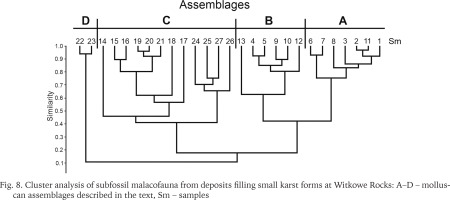
Assemblage A. This type of fauna is found in the bottom parts of profiles Ws-I, Ws-II, and Ws-III. The presence of cold-loving taxa (V. arctica, V. geyeri, C. columella, and S. kotulae) is a distinctive feature of this assemblage. Their proportion in individual samples is significant and varies between 55 and 85%. This assemblage is characterised by low species diversity, and in addition to the four taxa mentioned above, only shade-loving taxa with high thermal tolerance appears in relative abundance (A. arbustorum and D. ruderatus), the proportion of which in the assemblage may reach up to 40%. Only single specimens represent other species.
The ecological structure of the assemblage is characterised by a high proportion of shade-loving species of up to 50%. This group, however, is dominated by molluscs preferring light forests and shrubland zones (ecological group FB), while the proportion of typically woodland forms is low (Fig. 9). Mesophilous taxa, particularly typical of moist habitats, play a distinct role as well. It is worth paying attention to the moisture-loving snails (Fig. 9). The zoogeographical structure indicates a high proportion of Central European taxa, both upland and mountainous (around 50%). However, the most distinctive feature of the fauna under scrutiny is the abundant representation of North-European and Boreal-Alpine snails, accounting for about 40% of the assemblage (Fig. 9).
Fig. 9
Ecological and zoogeographical structure of subfossil and recent fauna from Witkowe Rocks: A–D – molluscan assemblages described in the text, E – ecological structure, F – shade-loving species, O – open-country species, M – mesophilous species, H – hygrophilous species (for explanations of other ecological groups see Fig. 7 and Table 1), ZG – zoogeographical structure, HP – species of wide geographical range, ME – Central-European snails, MO – European taxa of narrow geographical range (for explanations of other zoogeographical groups see Table 1)
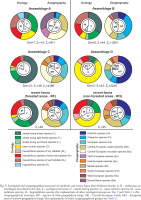
Assemblage A indicates a dominance of lightly shaded habitats (light forest and shrubland zones) and a cold climate.
Assemblage B. This fauna is found in the higher layers of the Ws-I, Ws-II, and Ws-III profiles. Its distinctive feature is the large proportion of D. ruderatus, which is the most important component of this assemblage, with its proportion reaching 50%. The assemblage is complemented by psychrophilic species (V. arctica, V. geyeri, C. columella, and S. kotulae), but they are noticeably less abundant than in assemblage A (representing up to 10% of the fauna). Taxa with high thermal tolerance are common, among which A. arbustorum and Vertigo substriata are most abundant. There are relatively few snails with higher thermal requirements.
Shade-loving taxa play a dominant role, accounting for more than 50% of the fauna. Compared to assemblage A, a spike in the occurrence of forest snails (ecological group FF) with a concurrent decline in the importance of ecological group FB is visible (Fig. 9). A high proportion of mesophilic species, up to 40% of the assemblage, persists. In contrast, hygrophilous snails are not present (Fig. 9). Compared to assemblage A, the zoogeographical structure of assemblage B is entirely different. Widely distributed Palaearctic and European taxa are prominent. At the same time, the proportion of North-European and Boreal-Alpine taxa is significantly lower (Fig. 9).
Assemblage B is typical of a coniferous forest environment growing on relatively moist soil and a cool climate.
Assemblage C. This type of fauna was recognised in profiles Ws-IV, Ws-V, and Ws-VI. It is characterised by high species diversity. Species of lower tolerance to cold temperatures (D. perspectivus, D. rotundatus, R. filograna, Ae. pura), are common here. Mesophilous snails are a substantial component of this fauna, while open-habitat species are only a minor addition.
This assemblage is characterised by the dominance of shade-loving snails, representing up to 80% of the fauna. Of particular prominence are taxa typical of deciduous and mixed forests. Among the mesophilous forms, taxa typical of habitats with average moisture levels predominate (Fig. 9). The zoogeographical structure is marked by a high proportion of Central European snails, especially mountain forms. The abundance of the species mentioned above is typical of the present-day fauna inhabiting the forested areas of the Kraków-Częstochowa Upland (Šteffek et al. 1990, Pawłowski et al. 2008, Stworzewicz 2008). The presence of thermophilous Balkan and South-European taxa is also a distinctive feature (Fig. 9).
Assemblage C is characteristic of a forest environment with a high proportion of deciduous trees and a relatively warm climate. Regarding species composition and ecological and zoogeographical structure, this assemblage shows strong similarities to the fauna of contemporary forested zones within Witkowe Rocks (Fig. 9).
Assemblage D. This fauna was found in only two samples (Ws-22 and Ws-23) in the uppermost part of the Ws-V profile. The dominant component of the assemblage is open-habitat taxa. Here are both snails typical of exposed and strongly insolated limestone walls (P. sterrii, P. pusilla, Ch. clienta) and open grassland biotopes (V. pulchella, V. costata). The proportion of open-country species is very high, reaching 80% (Fig. 9). Snails representing other ecological groups are less important. Among the mesophilous species, noteworthy is the presence of forms preferring open and dry habitats (Euomphalia strigella, C. lubricella) (ecological group MD). The assemblage is completed by shade-loving and mesophilous snails of environments with medium moisture levels, and their total contribution does not exceed 20% (Fig. 9). The assemblage is dominated by widely distributed taxa (75% of the fauna), especially Holarctic snails. On the other hand, the presence of thermophilic Balkan and Southern European snails should be highlighted, while Central European forms play a minor role. Regarding species composition and ecological and zoogeographical structure, the analysed assemblage shows strong similarities to the present-day malacofauna inhabiting forestless zones in the Witkowe Rocks area (Fig. 9).
DISCUSSION
SEDIMENT STRATIGRAPHY AND ENVIRONMENTAL ASPECTS
The stark differences in the taxonomic composition and ecological structure among these assemblages indicate that the sediments containing them were deposited during different climatic phases.
Assemblage A, which is dominated by cold-loving taxa plus species with low thermal requirements, shows remarkable similarity to the Early Holocene malacocoenoses from the southern part of the Kraków-Częstochowa Upland (e.g. Alexandrowicz S. W. 1983, 1987, Alexandrowicz W. P. 2004, 2021, 2022, Krajcarz et al. 2020, Wilczyński et al. 2020). Based on the composition of this fauna, it is also impossible to preclude its association with the Late Glacial, particularly with its slightly warmer Allerød phase. In this case, however, the comparative materials are much scarcer, and the sediments containing malacofauna of this age have only been documented on a handful of sites (Alexandrowicz S. W. 1983, Alexandrowicz W. P. 2004, 2022, Wilczyński et al. 2020). There is no doubt, however, that assemblage A represents a period of cold climate and an environment of thin, light forest growing on calcareous, relatively moist ground. Such habitats were dominant in the southern part of the Kraków-Częstochowa Upland both during the Allerød phase and the beginning of the Holocene (Alexandrowicz S. W. 1983, Alexandrowicz W. P. 2004, Madeyska 1995, 1998) (Fig. 10).
Fig. 10
Stratigraphy of deposits and environmental changes of Witkowe Rocks during Late Glacial and Holocene. AG – age (thousands of years), ST – stratigraphy (after Walker et al. 2019), MA – stratigraphical range of molluscan assemblages, MF – malacofauna (selected index species), A–D – molluscan assemblages described in the text, EN – environmental changes
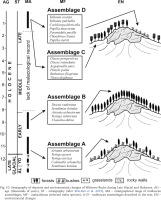
Assemblage B, characterised by the abundance of D. ruderatus, the presence of species with high ecological tolerance as well as cold-loving taxa, shows significant similarity to the so-called ruderatus-fauna (Dehm 1967), an assemblage considered indicative of the Early Holocene. Malacocoenoses of similar taxonomic composition and structure have been reported from numerous Quaternary profiles throughout central and western Europe (e.g. Gedda 2006, Meyrick 2002, Limondin-Lozouet & Preece 2004, 2014, Limondin-Lozouet 2011, Alexandrowicz W. P. 2013, Alexandrowicz W. P. et al. 2014, Juřičkova et al. 2014b, Horáčková et al. 2015, Horsák et al. 2019, Granai et al. 2020), including many sites of calcareous tufas and fluvial deposits in the southern part of the Kraków-Częstochowa Upland (Fig. 10) (e.g. Alexandrowicz S. W. 1983, 1987, Alexandrowicz W. P. 2004, 2021), indicating uniform environmental conditions prevailing in the area. Similar faunas have also been found in the fills of large caves around Kraków (e.g. Alexandrowicz S. W. et al. 1992, Cyrek et al. 2000, Wilczyński et al. 2012, 2020, Szymanek et al. 2016, Krajcarz et al. 2020, Alexandrowicz W. P. 2022). The ecological structure of the fauna under scrutiny indicates that at the time of the deposition of the sediments, the area of Witkowe Rocks was covered by a dense forest with a high proportion of conifers and relatively moist ground and cool climate with marked continental features predominated.
Malacocoenoses with composition and structure corresponding to assemblages A and B have not yet been found in sediments filling small karst forms in the Upland. In Poland, such sites have only been reported in the Podhale Basin and the Pieniny Mountains (Alexandrowicz W. P. 1997, Alexandrowicz S. W. 2001, Alexandrowicz W. P. & Rudzka 2006, Skoczylas-Śniaz & Alexandrowicz W. P. 2022). Similar sites have been found in the Czech Republic and Slovakia (Ložek 1972, 1980, 1981, 1989, 2000). From this point of view, the profiles in Witkowe Rocks representing the Early Holocene (or even Late Glacial) should be considered very valuable. The main reason for such rare finds of fills of small karst forms containing malacocoenoses of this age is the low resistance of these sediments to erosional processes. Unlike in large caves, where deposition takes place over long periods punctuated by relatively short erosion phases, small karst forms, due to their shape, undergo repeated periods of deposition and erosion over short intervals of time (on the order of several hundred years). As a result, the accumulated sediments are entirely or almost completely removed in the subsequent erosion episode. Consequently, in most small karst forms, only the youngest fills accumulated over the last few hundred years are preserved. Studies of similar sites in the Kraków-Częstochowa Upland lead to similar conclusions (e.g. Alexandrowicz S. W. 1992, 2000, Alexandrowicz W. P. 2000, Alexandrowicz S. W. & Alexandrowicz Z. 2003).
Regarding specieas composition, assemblages C and D are similar to the malacocoenoses now inhabiting Witkowe Rocks. Thus, it can be assumed that the fills of small karst forms containing it are related to the youngest Holocene, probably representing the last few hundred years, as stated above. Assemblage C represents a mixed forest environment with a significant proportion of deciduous trees. Assemblage D is characteristic of open habitats with intense sunlight and dry grassland or rocks. Observations of contemporary and Late Holocene subfossil assemblages in the southern part of the Kraków-Częstochowa Upland indicate that the two assemblages mentioned above frequently inhabit adjacent areas. There are significant differences in their species composition and microhabitat condition structure mainly due to slope exposure (the slopes facing south tend to have D-type fauna, and the slopes facing north tend to have C-type fauna) and slope morphology (the rocky slopes are dominated by petrophilous taxa and the grassy slopes by meadow taxa). The fact that both types of malacocoenoses occur within single profiles (in the case of Witkowe Rocks, the Ws-V profile) indicates that a significant change in environmental characteristics has occurred during sediment deposition. These changes can be caused by human interference (deforestation) or local natural factors (e.g. fires, mass movements, windfalls). There are no traces of anthropogenic processes in the Witkowe Rocks area, so the change in the characteristics of the malacocenoses in the Ws-V profile is related to natural factors. In contrast, there are clear signs of human activity on many other inliers in the Jerzmanowice area (Alexandrowicz S. W. & Alexandrowicz Z. 2003) (Fig. 10).
Given that around 90 species of land snails are recorded in the southern part of the Kraków-Częstochowa Upland (Riedel 1988, Wiktor 2004), the malacofauna of Witkowe Rocks is relatively rich.
CONCLUSIONS
Analysis of the subfossil malacofauna in Witkowe Rocks points to the existence of different generations of fills of small karst forms.
The oldest fills contain a relatively sparse fauna of low taxonomic diversity with cold-loving species that are mostly not found today in the southern part of the Kraków-Częstochowa Upland. Another distinctive feature is the abundance of taxa with a restricted geographical range, particularly North-European and Boreal-Alpine. The composition and structure of the malacofauna suggest a link to the Early Holocene or even the Late Glacial.
The younger generation of fills contains a malacocoenosis with a high proportion of shade-loving taxa typical of cool climates and coniferous forests. Moreover, there is a marked increase in the proportion of widely distributed Palaearctic and European species, with a simultaneous decline in the prominence of Boreal-Alpine taxa. This malacocoenosis has a typical composition and structure for assemblages associated with the Early Holocene.
In the youngest fills, a rich and highly diverse fauna was identified, with a taxonomic composition and ecological structure similar to the present-day malacocoenoses in the area. These are, therefore, most likely assemblages associated with the Late Holocene during the last few hundred years. Depending on local conditions, these faunas may be dominated by shade-loving taxa (in forested zones) or open-habitat species (living in grasslands and/or on rocks) in forestless zones.
Malacocoenoses occurring in small karst forms represent short periods (periods of a few hundred years at most). This is due to the high susceptibility of the sediments to erosion and the presence of relatively abrupt successive cycles of deposition and erosion. During the latter periods, some or all of the previously accumulated fills and the malacological record are removed.
Profiles Ws-I, Ws-II, and Ws-III, which contain Early Holocene and/or Late Glacial malacocoenoses, are the first described infill sites of small karst forms in the Kraków-Częstochowa Upland of such age.
In the area of Witkowe Rocks, a rich fauna of shelled snails was found, including 58 species. This constitutes approximately 60% of taxa recorded from the southern part of the Kraków-Częstochowa Upland.
In the contemporary malacofauna inhabiting Witkowe Rocks, species rarely reported in the Kraków-Częstochowa Upland have been found. These include D. perspectivus, R. filograna, and V. subrimata.
Unlike many of the limestone rocks in the Jerzmanowice area, Witkowe Rocks are not under legal protection. The contemporary malacofauna found here and the regionally unique sites of subfossil molluscs make it advisable to protect the area from anthropogenic devastation.

